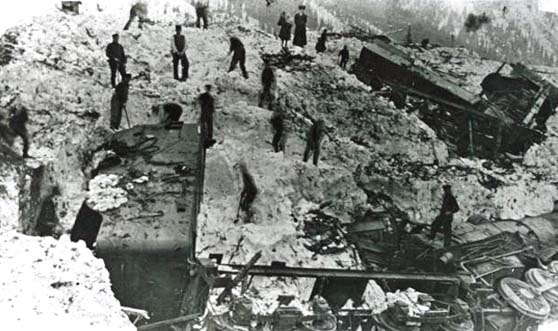
4 March 2010
Impact of Killer Slide Near Revelstoke has Lasted a Century

Clearing out the tracks after the 1910 Rogers Pass Slide.

Rogers Pass British Columbia - Crouched in a pit about two metres deep, Duncan McRae heard the
sound of trees snapping under the weight of the snow pack thundering down Mount Cheops and knew he had to flee.
It was 4 Mar 1910, and McRae was with a Canadian Pacific Railway crew furiously digging out a stretch of track in the avalanche-prone Rogers Pass that had been
buried in a slide earlier that day.
Just before midnight, the second avalanche came blistering down.
"I heard trees cracking above us and knew the worst, that we were in the wake of a big slide coming down upon us. I shouted, Everybody look out. I was in
a pit about six feet deep and climbed out to run, but the fresh, soft, and deep snow made running impossible. No sooner had I got out than the wind of the
slide caught me and pushed me on," McRae recalled.
A massive rotary snowplow and steam locomotive were flung aside as the slide careened down on the crew, killing 58 men in the largest avalanche disaster in
Canadian history.
One hundred years later, McRae's words, recorded in a newspaper interview just eight days after the slide, are among the hundreds of pages of documents,
letters, and photos carefully stored in the Revelstoke Museum and Archives.
The documents aren't the only legacy of the slides, though.
The deadly avalanche also set the stage for the major advancements in technology, science, and education that have helped ward off similar catastrophes in the
past 100 years, said Parks Canada spokeswoman Jacolyn Daniluck.
"Little has changed in the mountains. What's changed is how we interact with the elements that create avalanches," Daniluck said.
Parks Canada's mobile avalanche control program in Rogers Pass, B.C., the largest of its kind in the world, uses artillery fire to shoot down unstable snow and
stabilize snowpacks before avalanches can develop. The program is just one of the tools used by parks officials as part of a network of safety professionals
working to keep the nation's mountain passes safe in the winter, said Daniluck.
The sheer loss of life in the 1910 event is also what makes the story so striking, said Cathy English, curator of Revelstoke Museum and Archives.
An anniversary ceremony is planned for today in Revelstoke.
By modern standards, the avalanche risk the night of the monster 1910 slide was off the charts. A blizzard raged with wind and snow whipping through the
mountain landscape.
But a smaller slide had covered a portion of the tracks, and a passenger train was waiting to get through, said English. As per course, a crew of men were
called to dig out the tracks.
Just before midnight, road master John Anderson stepped down the road to advise the Revelstoke dispatcher their work was nearly done. When he returned, the
men were gone.
In Revelstoke, Canadian Pacific steam whistles screamed and the fire gong rang loudly to alert locals to the disaster, recalled Donald Scott-Calder, who was
16 at the time and on his way home from a party.
Still dressed in his evening finery, he grabbed a shovel and boarded a rescue train that took him up into the mountains, he wrote in a document preserved in
the Revelstoke museum.
Donning warmer gear to protect from the wintry blast, he chipped away at the frozen debris left by the slide. It seemed a hopeless task.
"It would be miracle if any of them were alive," Scott-Calder wrote. "... For the fist time in my life (I) had come face to face with violent
death."
At least six hundred men, from as far away as Banff and Calgary, helped in the rescue and recovery operation.
Today, prayers and reflections will be offered in honour of those who died, followed by a howitzer salute in the 100 anniversary ceremony in Revelstoke. The
handiwork of hundreds of people from across Canada, who folded origami paper cranes and linked them together as part of a Japanese tradition to make a wish
come true, will be unveiled.
According to English, though the 1910 slide is deep in the past, its memory lives on. "It was the worst avalanche disaster in Canada and it did have a
huge impact on the community and the railway as well."
Jamie Komarnicki.

|

